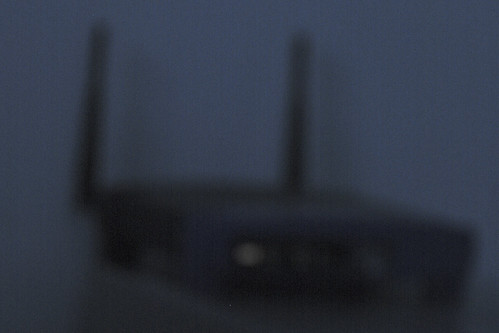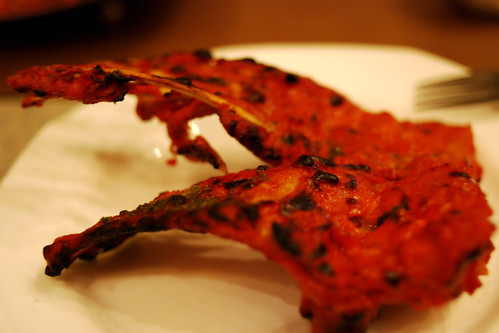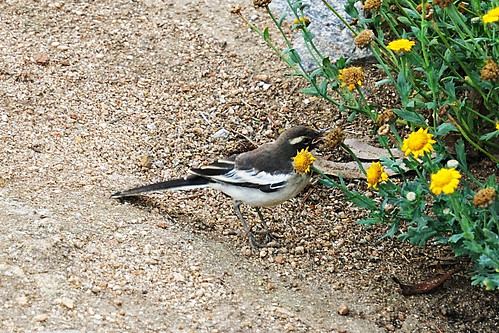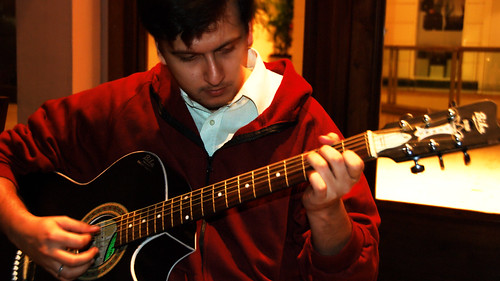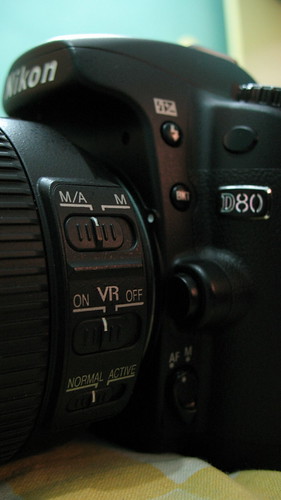Digital sensors have made a lot of progress on the light efficiency front. The Nikon D3s sensor, currently the most efficient sensor available, offers amazingly clean images at crazy high ISOs. Something that film shooters could only dream of. There is still some time, however, before a D3s calibre sensor makes it to consumer bodies. Meanwhile, it will help knowing the tips and tricks of shooting in the dark for the win.
Gear
Before proceeding further on the topic, I’d like to say that the best thing to do is simply not shoot in low light. Most low light situations can benefit hugely from an off-camera speedlight bounced from the ceiling or walls. This essentially involves placing a large external flash like the SB-600 somewhere out of your field of view (your camera’s hot shoe is also a good candidate) and pointing it toward the ceiling. You can now happily shoot at ISO 200 and enjoy good, clean images with soft pleasant lighting. The following shot of pizza toppings was made at f/5.6, ISO 400, 1/60s in ambient light provided by 2 11-watt CFLs. Without the flash, this shot would have had less tonality, more noise and perhaps motion blur (corresponding flash-less settings would be something like ISO 3200, 1/8s).
The other very important piece would be a lens that has a large aperture, i.e. at least f/2.8 or larger. The AF 50mm f/1.8 D Nikkor aka Nifty-Fifty is a good, inexpensive purchase. Beware, though, shooting at very wide apertures places a big ask on focus accuracy because the DoF at large apertures might become too thin to be workable. Auto-focus systems also tend to perform poorly in low light. One useful tip for shooting people with wide apertures is to try and focus on the near eye — eyes are easier for AF systems to lock on, and it gives a natural guide for the viewer of the photograph.
Despite having the best gear, you still might end up in situations where you can’t do anything but bump up the ISO and face the lack of light. That’s where some of the following techniques will help.
Taking the Photographs
1. Exposure vs. ISO
The first time I was faced with shooting in low light, the camera metered some terribly low shutter speed like 1/20s at ISO 640, which is tough to shoot with even in low light. I decided to under-expose by a stop at the same ISO to get up to 1/8s because I didn’t want to hit the limit of the ISO range at 1600. Higher ISO = More Noise, right? Yes, provided the exposure is comparable in both. Under-exposure results in even more noisy photos. My shots from the above-mentioned sequence were all wasted. Here’s a noisy, under-exposed shot. Do you want to guess what ISO the following shot was made at?
ISO 100! You can see the effect of -5 EV under-exposure on the noise even in this small version. It would print really horrible on 6″x4″ paper. When you have to choose between underexposing and bumping up the ISO to get to a desired shutter speed, always go for higher ISO. An underexposed, low ISO shot is almost always more noisy than a properly exposed high ISO shot. Here’s another shot where I chose to over-expose +2/3 EV even at ISO 1600, to allow good tonality and saturation. The result speaks for itself.
2. Auto-Focus
Another area that suffers badly in low-light is auto-focus. Most AF systems try to lock in on edges that they find under the focus points where the boundaries appear the sharpest. This turns out to be difficult in low light because the difference in light intensity between light and dark parts of an edge are reduced. Having a speedlight like the SB-600 helps here, because it projects a focusing grid on to the field of view (much like the red grid you might see in supermarket barcode readers). If you find your hardware failing, you could try some of these tricks:
- Zoom-in; Focus; Zoom-out: This works if you have a zoom lens that’s not “varifocal“, i.e. its focus doesn’t change while zooming in and out. The trick is to zoom all the way in, acquire focus — either manually or automatically — and zoom out to the frame you want. Most of the modern SLR zoom lenses are parfocal. I know that the 18-200mm f/3.5-5.6 VR Nikkor works.
- Focus and Recompose: Sometimes, we would like to focus on a subject that’s not contrasty enough for AF or manual focus to work. In this case, it might be helpful to focus on a more edgy object at roughly the same distance and recompose. The results are iffy, though. Also, if you are not able to verify exact focus through the camera view-finder, chances are that your photograph would pass on as fairly in focus, anyway.
- Live View: Most new DSLRs now support Live View feature. Live View can help you a lot when trying to focus manually. Turn on Live View and zoom all the way in on the view. Since you’re zooming in on the image preview and not on the lens itself, this trick works even with non-parfocal lenses. I made the following shot using the same technique in fading daylight. The AF was being tricked too often by the bushes and rubble, and generally being unable to cope with the fast moving bird.
3. People Shots with Slow Sync Flash
One of the most frustrating experiences in low-light shooting is blurry people shots. When your shutter speeds drop to levels below 1/20s, asking people to stand still also doesn’t help. You end up needing to try something else. You also can’t pop the on-board flash because
- it gets into people’s eyes (not a problem with ceiling bounce), and
- it doesn’t bring out the ambient light properly, leading to an unpleasant photograph.
Issue #2 can be solved by using the flash in “Slow Sync” mode. In this mode, the flash fires for a short time (1/60s) but the shutter stays open for as long as it would have opened without the flash. You can choose whether the flash fires in the beginning of the exposure (Front Curtain Sync) or toward the end (Rear Curtain Sync). Why would you use slow sync instead of just shooting without flash? Because it de-emphasises motion blur that occurs while the flash is not on and captures a sharp outline when the flash pops.
While shooting people in slow sync mode, Rear curtain sync works better than front curtain for two reasons. One, people don’t notice a snap until the flash goes off. In front curtain, they tend to think that the snap is done when the flash goes off and let go of their pose while the shutter is still open. This leading to blurry shots.
Secondly, rear curtain captures motion in the forward direction. You get to see the final position of a moving object most prominently, which is more natural than seeing the starting position of an object and seeing a blur in its later direction of movement.
While using slow-sync, just always remember to disable pre-flashes by using FV lock to determine exposure. You want your flash to fire exactly once, and toward the end of the exposure, to get people to instinctively comply with the slow shutter. You might also want to use an orange colour gel in front of your flash if you don’t want the people to appear blue while shooting in incandescent light. Here’s a 1/8s full-on action shot of my friend strumming on the guitar, taken using this technique. If you look carefully, you could reveal a lot more motion blur than what is apparent in first glance. That’s the rear sync advantage!
4. Camera Stability
One of the easy ways of success in low light is to be able to use slow shutter speed, at least for relatively still subjects. The problem here is that slow speed results in camera shake. It is, therefore, important to learn how to have a stable grip on the camera. I myself, took a very long time getting this right. Part of the reason is that people talk about this aspect very infrequently on forums. Part of it is that you only get the information in bits and pieces. I’d invite you to go through this excellent blog post on how to make a “human tripod”. Supporting the camera: holding with your hands.
One of the techniques I often apply when faced with camera shake is to burst a series of shots. Chances are that one of those shots will be sharp. It frequently happens to be the first in the series and I find bursting for more than 2 seconds to be a waste. The following is a 1/4s shot made using a Canon PowerShot A630 P&S in burst mode.
That’s it for this article. It still talks about shooting at high ISO and it is inevitable that you’ll get noise in such shots. In the next post, I’ll talk about development techniques that would help you reduce the apparent noise, beyond just pushing the NR slider all the way up. Oh yeah, you’re shooting RAW, aren’t you? 😉

